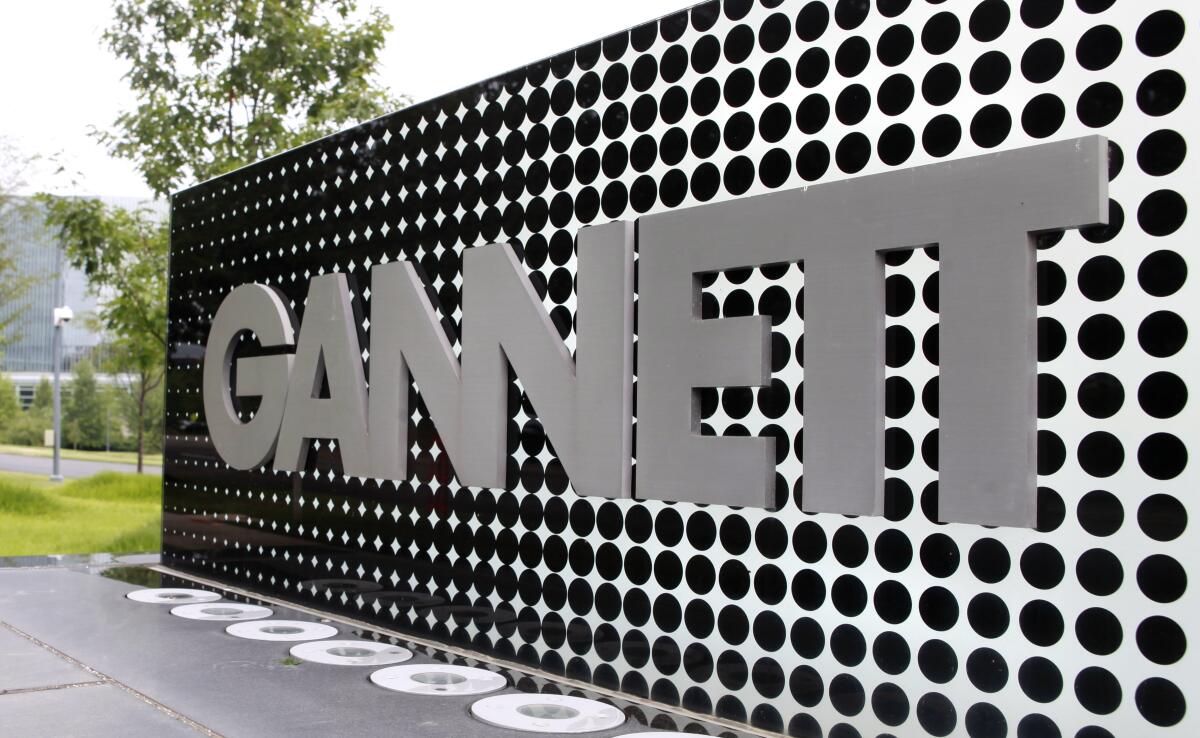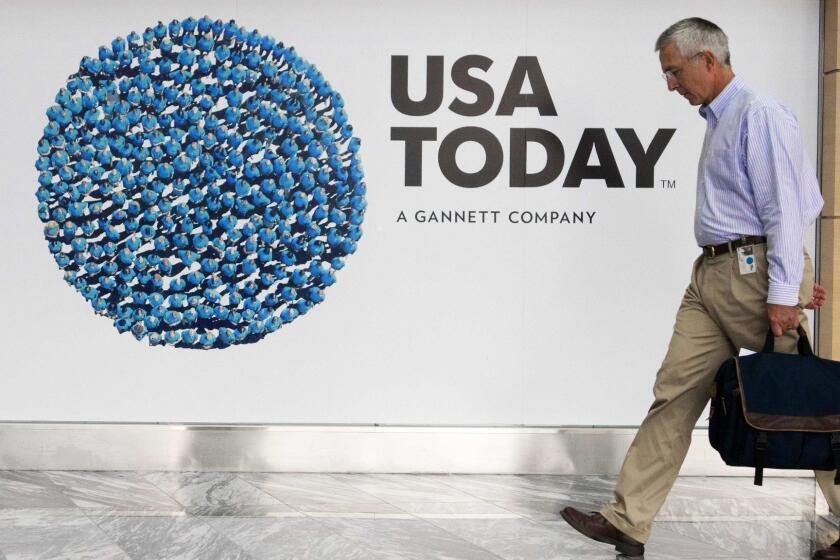Column: How the decline of local news exposes the public to lies and corruption

- Share via
Gannett Co., the largest newspaper chain in the country, had some encouraging news for its news staff and readers in July.
That’s when one of its top executives declared that the company remained “unrelenting in our commitment to the communities we serve and will continue to deliver bold and uniquely innovative reporting ... for our loyal readers.”
Fast-forward just a few weeks later, and the word wasn’t so uplifting.
There’s no magic cure to the ailments of the local news industry.
— Tim Franklin, Northwestern University
On Aug. 4, the company delivered a bleak earnings report for its second quarter, which ended June 30: a loss of $53.7 million on revenue of $748.7 million. That came on top of losses totaling nearly $1 billion over the prior three calendar years, on revenues of nearly $7 billion.
Gannett’s commitment to delivering “bold and uniquely innovative reporting” seemed shaken. Maribel Perez Wadsworth, the head of Gannett media, who had made that earlier commitment, was now warning that layoffs were looming.
Get the latest from Michael Hiltzik
Commentary on economics and more from a Pulitzer Prize winner.
You may occasionally receive promotional content from the Los Angeles Times.
“In the coming days,” she said, “we will … be making necessary but painful reductions to staffing, eliminating some open positions and roles that will impact valued colleagues.”
She was as good as her word. At least 70 layoffs have occurred in Gannett newsrooms since mid-August, according to a reckoning by the Poynter Institute; the NewsGuild, which represents workers at many of those locations, counts at least 80. Gannett hasn’t confirmed any numbers.
The layoffs are a blow not only to the men and women who have lost their jobs but also to the readers who relied on them to keep them informed, to keep their elected officials and business leaders honest, and to provide the glue that brings neighbors together as a community.
As the owner of more than 400 local weeklies and dailies in 46 states, Gannett stands as a telling illustration of the economics of local newspapers. It’s not just a matter of costs outpacing revenues but a question of where the costs are coming from. Gannett has accumulated $1.34 billion in debt, much of it due to its merger with GateHouse Media, another big newspaper chain, in 2019.
The merger hasn’t seemed to result in cost-saving economies of scale. Instead, it has cut costs by offering readers less — fewer reporters and editors producing fewer local news stories.
Where has the money gone? Last year, Chief Executive Michael Reed collected $7.74 million in cash and stock awards (an incentive bonus could bring his total pay to as high as $8.5 million). His second-in-command, Douglas E. Horne, got $1.75 million.
Then there’s the nine-member board of directors — eight plus Reed. They include a former director and executive of a casino services firm, a former marketing executive for a cruise line and a former executive of a footwear company. The eight non-management directors collected an average of $242,969 each in 2021.
Gannett spokeswoman Lark-Marie Antón told me by email that the executives’ compensation is “aligned with Gannett’s financial performance” and based on performance goals overseen by the board.
Among those who believe that the press provides value for society — especially local journalism that slaps state and municipal politicians’ hands out of the public cookie jar — Alden Global Capital is a “vulture investing” firm that makes real vultures look good by comparison.
The median pay of Gannett’s approximately 16,000 employees last year, including reporters and editors, was $48,419. The ratio between Reed’s pay and theirs was 160 to 1. That’s not the largest mismatch between the compensation of a CEO and the workforce, but it’s far from the smallest.
Antón wouldn’t say how many reporters and editors have been laid off by Gannett in the latest round of cutbacks, but said “these staffing reductions are incredibly difficult.”
She pointed to a number of outstanding recent journalistic accomplishments by the company’s local reporters, and it’s true they shouldn’t be overlooked. They include the verification by the Indianapolis Star and Columbus Dispatch of the story about the 10-year-old Ohio girl forced to travel to Indiana to obtain an abortion, despite the effort of conservative politicians and some journalists to cast doubt on the story; and coverage of the inadequate police response to the school shooting in Uvalde, Texas, by the Austin American-Statesman.
Yet the valor and skill of those reporters and editors don’t outweigh the larger trends at Gannett. Its ills are at least partially the consequence of management choices. In some respects those choices predate the internet age, when digital media began to weaken newspapers’ traditional grip on retail and classified advertising.
Gannett was long known for a hyperlocal approach that aimed to appeal to hometown readers, but after the company launched USA Today as a national publication in 1982, more features in the individual papers were shared content and the local product began to look and feel homogenized. That may have hampered its efforts to keep local readers on board.
Red ink is not inevitable in the newspaper business. Lee Enterprises, a publicly traded company that owns 77 newspapers in midsize communities in 26 states, has been consistently profitable on an operating basis since 2014, though it hasn’t been immune to staff layoffs — partially in an apparent effort to stave off a hostile takeover attempt by Alden Global Capital, a hedge fund that is known for ruthlessly cutting staff at its newspaper properties. Lee’s CEO, Kevin Mowbray, collected $2.2 million in compensation in 2021.
It may be tempting to point the finger at Gannett as especially maladroit at dealing with the economic and social changes that have forced the entire news industry into a painful retrenchment. The trends include the evaporation of advertising as new media drain away sponsors and the incursion of other information sources, including social media platforms and partisan websites, erodes newspapers’ franchises.
The causes are almost beside the point.
What’s important is their consequences. The effects of the spread of “news deserts” on social and political cohesiveness in America, and the vacuum it has left to be filled by fringe ideologues, political mountebanks and corporate PR departments — “misinformation engines,” in the words of Steve Waldman, co-founder of Report for America, an organization that places journalists in local newsrooms to report on local issues.
It’s probably no coincidence that the incursion of loudmouthed extremists into our political discourse has been growing as solid, locally based news reporting has been shrinking.
If you happened to click Monday on the Richmond Standard, a community news site for that Bay Area locality, you would have come upon a fairly snarky piece about 170 activists (“some from Richmond”) who took a train cross-country to participate in the People’s Climate March in New York on Sunday.
The decline was rapid before the pandemic but has picked up speed ever since. “In the 15 years leading up to 2020,” reported Penelope Muse Abernathy of the University of North Carolina that year, “more than one-fourth of the country’s newspapers disappeared, leaving residents in thousands of communities — inner-city neighborhoods, suburban towns and rural villages — living in vast news deserts.”
Between 2018 and 2020 alone, she calculated, “300 newspapers closed, another 6,000 journalists employed by newspapers vanished, and print newspaper circulation declined by 5 million.”
Among the survivors, “consolidation also increased, with the largest chains, backed by private equity firms and hedge funds, racing to merge with the last surviving publicly traded companies and form mega-chains with hundreds of newspapers, and management focused on shareholder return over journalism’s civic duty.”
The loss of communal knowledge has been incalculable. “The watchdogs of school boards, city councils and quorum courts are gone, the chroniclers of high school sports teams are missing,” Rex Nelson of the Arkansas Democrat-Gazette wrote in 2018 after GateHouse Media abruptly shuttered three of the state’s oldest dailies; the move came after GateHouse had closed two other Arkansas dailies and consolidated five others into two. “To say that this is a sad thing for these counties is to understate the case.”
GateHouse merged with Gannett in 2019.
Nelson is right to observe that the disappearance of local news sources saps a sense of community.
As Waldman reported, it leads to lower voter turnout, more pollution, more corporate crime. It can also be expensive: Researchers at Notre Dame and the University of Illinois showed in a 2019 paper that it can even drive up municipal borrowing costs, perhaps because investors are uneasy about the loss of monitoring of local government expenditures.
After the Denver Rocky Mountain News closed in 2009, the authors found, municipal borrowing costs rose by an average of more than one-third of a percentage point.
Column: Chevron builds a ‘newsroom’ to tell stories it doesn’t think an independent press will cover
A job posting by Chevron indicates the fossil fuel company is hiring staff to write articles on the company’s behalf.
Among that newspaper’s cost-saving investigations had been “an audit of questionable federal funds that were allocated to the local sheriff’s department, a handshake deal between the city government and Lufthansa Airlines that may have violated federal law, ... and an ‘under the table’ scheme at the Denver International Airport in which employees were being paid for undeserved wages.”
The disappearance of a local newspaper can spur corporate misconduct, Jonas Heese of Harvard Business School and colleagues reported last year.
“After a local newspaper closure, local facilities increase violations by 1.1% and penalties by 15.2%, indicating that the closures reduce firm monitoring by the press,” they found. “Newspapers may be especially effective in discovering the misconduct of local firms because of their proximity to local sources such as employees and local suppliers.”
They play an important role in national coverage of corporate conduct too, because “they provide the national press with credible information on local misconduct.”
Self-interested players have swept in to take up the slack. We reported in 2014 on Chevron’s creation of a corporate PR site masquerading as a community news source in Richmond, Calif., where it operated a huge refinery, and this year on its effort to continue the dissemination of “news articles” designed to proactively preempt reporting it can’t fully control.
Chevron has now brought its strategy to Texas, which has suffered the loss of more journalists per capita than all but two other states. There the company sponsors “Permian Proud,” a purportedly community website that says, in small print, that it aims to provide Permian Basin residents with information about what’s going on in the community, and to provide a voice for CNAEP [that is, Chevron] on civic issues.”
Make no mistake: The newspaper industry connived in its own decline. Consider the Providence Journal, where I worked in the 1970s and early ‘80s, when it was renowned as one of the most energetic and enterprising local news organizations in the country.
In its heyday, the Journal and its sister newspaper, the Evening Bulletin, had 11 local community bureaus, plus a centrally located staff of city and state government and investigative reporters.
We used to joke that there were days when nothing that happened in the state of Rhode Island didn’t get reported in the Providence Journal. Almost every one of the state’s nearly 40 municipalities had at least one reporter assigned; the largest bureau, in suburban Warwick, had 11 reporters. The Journal now lists 13 reporters on its staff directory to cover the entire state, plus veteran columnist Mark Patinkin and three sportswriters.
The ingenuity of big corporations knows no bounds, especially when it comes to disguising self-interested PR as objective information.
“The Journal doesn’t even try to portray itself as the watchdog newspaper for the state any more,” says Tracy Breton, a Pulitzer Prize-winning colleague of mine at the time who later moved on to a professorship at Brown University. “There are cities and towns that might be bankrupt right now and the Providence Journal wouldn’t know that.”
I asked David Ng, the Journal’s executive editor, to respond, but didn’t receive a reply.
The Journal was family-owned for much of its history, then sold to A.H. Belo Corp. in 1996. By then, the Bulletin had been closed and the consolidation of the local bureaus begun. Circulation, which had topped 200,000 in 1990, fell below 30,000 on weekdays in 2021. As did many other newspapers, the Journal reduced coverage and raised prices — sort of capitalist strategy from the Bizarro world, as Jerry Seinfeld might say.
What will stem the expansion of local news desertification is unclear, though there’s no dearth of initiatives.
Some gaps are being filled by local civic-minded investors. Among them is Patrick Soon-Shiong, a Los Angeles biotech billionaire who bought The Times, along with the San Diego Union-Tribune and some other community publications, for $500 million from Tribune Co., which had acquired The Times in 2000.
Since then, new management has been working to rebuild the newspapers’ news staff after nearly two decades of decline under its Chicago-based owners.
Another example is the Baltimore Banner, which was founded by local entrepreneur Stewart Bainum Jr. as an online nonprofit to fill the news vacuum created by the decline of the Baltimore Sun, a 135-year-old institution that had been acquired by Tribune, which was in turn acquired by Alden in 2021.
Restoring a community’s trust in its news sources after years of decline is the principal challenge for such new enterprises, says Kimi Yoshino, a former editor at The Times who is the Banner’s editor in chief.
Yoshino has focused on building the Banner’s coverage of City Hall, education, criminal justice, and arts and culture, with plans to add coverage of transportation and the environment. “We’re trying to write stories that impact people’s lives.” The Banner currently has 50 staff members but expects to have a larger staff by the end of the year than the Sun.
The nonprofit route is also being followed by the Austin-based Texas Tribune, which was launched in 2009 and is funded by Texas foundations and philanthropists, and a growing membership base of small-dollar donors and live events programming. The Tribune is now under the leadership of Sewell Chan, another former Times editor, as editor in chief.
“Civic news, democratically relevant news, investigative news is a public good,” Chan says, “but it’s time-consuming and expensive, and unfortunately there isn’t necessarily a clear market demand for it.”
Although the Tribune remains “very politics-obsessed,” Chan says, “our mission has broadened to connect the dots more to show the impact of policies that are made in Austin on ordinary communities and ordinary people. Accountability journalism has to resonate if it’s going to be read.”
“There’s no magic cure to the ailments of the local news industry,” observed a recent study by Tim Franklin, an expert in local news at Northwestern University’s Medill School of Journalism. “Aggressive cost cutting hasn’t solved the problem and is likely making it worse. Policymakers in Washington and in statehouses have so far failed to advance solutions. Philanthropic institutions have stepped up, but there aren’t enough charitable dollars to spare an entire industry.”
Some universities have also made contributions — for example, UC Berkeley journalism students operate Richmond Confidential, a community news source designed to be a counterweight to Chevron’s Richmond Standard.
But other efforts are dubious, including proposed federal measures such as the Journalism Competition and Preservation Act and the Local Journalism Sustainability Act, which would grant antitrust exemptions and tax breaks to news organizations, potentially creating an unholy alliance between government and the news industry. Neither has passed.
The search for answers will continue as long as the need for information exists — and that is eternal. “Informed citizens are too essential to the health of America’s democracy to let the local news industry that has long been responsible for performing this important task die off,” Clara Hendrickson wrote for the Brookings Institution in 2019.
But it’s easier to state the problem than to solve it. As Breton told me, “Newspapers will die if they aren’t offering people what they’re paying for and keep raising prices for the product.”
More to Read
Get the latest from Michael Hiltzik
Commentary on economics and more from a Pulitzer Prize winner.
You may occasionally receive promotional content from the Los Angeles Times.














